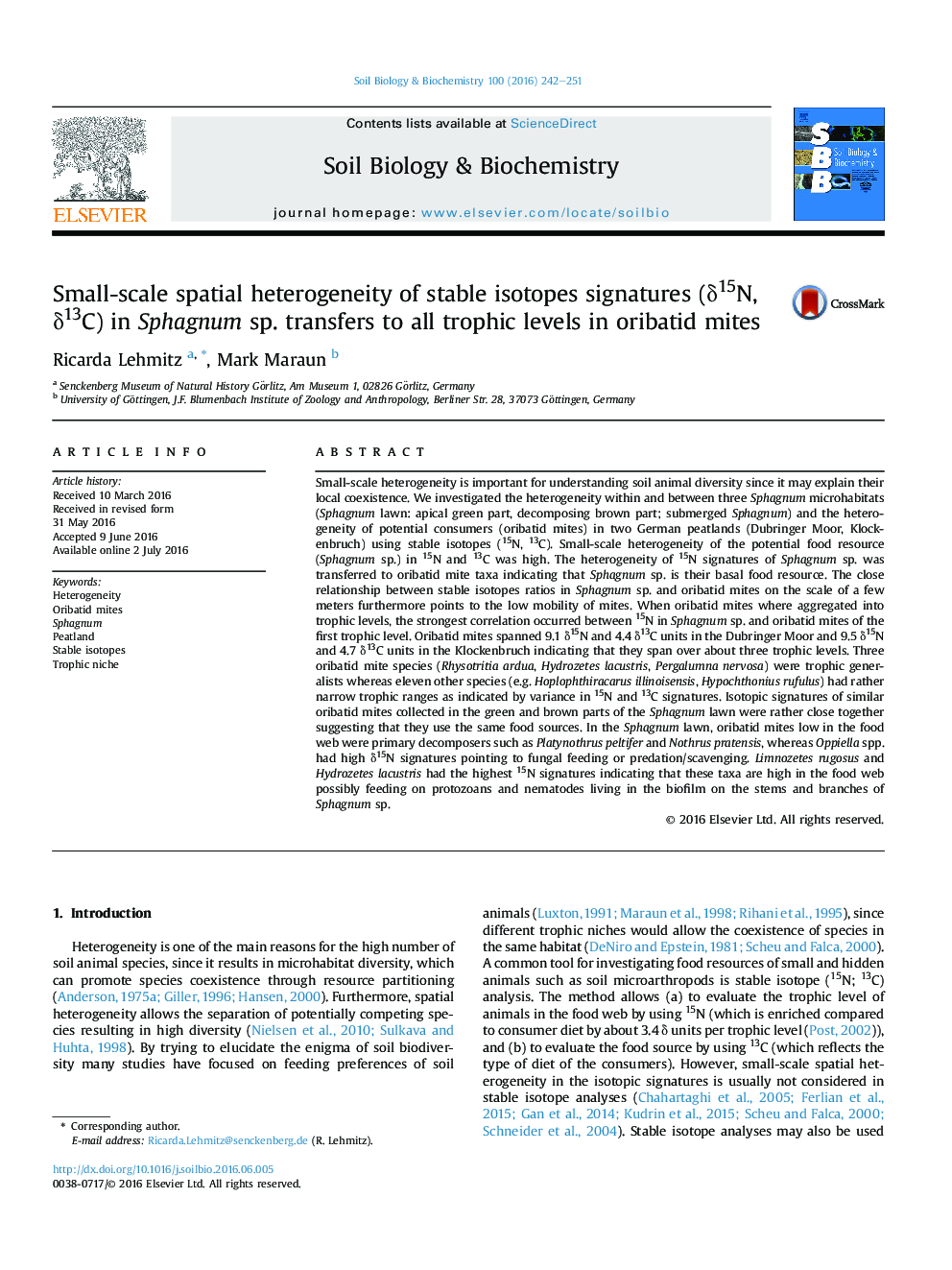| کد مقاله | کد نشریه | سال انتشار | مقاله انگلیسی | نسخه تمام متن |
|---|---|---|---|---|
| 8363519 | 1542584 | 2016 | 10 صفحه PDF | دانلود رایگان |
عنوان انگلیسی مقاله ISI
Small-scale spatial heterogeneity of stable isotopes signatures (δ15N, δ13C) in Sphagnum sp. transfers to all trophic levels in oribatid mites
دانلود مقاله + سفارش ترجمه
دانلود مقاله ISI انگلیسی
رایگان برای ایرانیان
کلمات کلیدی
موضوعات مرتبط
علوم زیستی و بیوفناوری
علوم کشاورزی و بیولوژیک
دانش خاک شناسی
پیش نمایش صفحه اول مقاله

چکیده انگلیسی
Small-scale heterogeneity is important for understanding soil animal diversity since it may explain their local coexistence. We investigated the heterogeneity within and between three Sphagnum microhabitats (Sphagnum lawn: apical green part, decomposing brown part; submerged Sphagnum) and the heterogeneity of potential consumers (oribatid mites) in two German peatlands (Dubringer Moor, Klockenbruch) using stable isotopes (15N, 13C). Small-scale heterogeneity of the potential food resource (Sphagnum sp.) in 15N and 13C was high. The heterogeneity of 15N signatures of Sphagnum sp. was transferred to oribatid mite taxa indicating that Sphagnum sp. is their basal food resource. The close relationship between stable isotopes ratios in Sphagnum sp. and oribatid mites on the scale of a few meters furthermore points to the low mobility of mites. When oribatid mites where aggregated into trophic levels, the strongest correlation occurred between 15N in Sphagnum sp. and oribatid mites of the first trophic level. Oribatid mites spanned 9.1 δ15N and 4.4 δ13C units in the Dubringer Moor and 9.5 δ15N and 4.7 δ13C units in the Klockenbruch indicating that they span over about three trophic levels. Three oribatid mite species (Rhysotritia ardua, Hydrozetes lacustris, Pergalumna nervosa) were trophic generalists whereas eleven other species (e.g. Hoplophthiracarus illinoisensis, Hypochthonius rufulus) had rather narrow trophic ranges as indicated by variance in 15N and 13C signatures. Isotopic signatures of similar oribatid mites collected in the green and brown parts of the Sphagnum lawn were rather close together suggesting that they use the same food sources. In the Sphagnum lawn, oribatid mites low in the food web were primary decomposers such as Platynothrus peltifer and Nothrus pratensis, whereas Oppiella spp. had high δ15N signatures pointing to fungal feeding or predation/scavenging. Limnozetes rugosus and Hydrozetes lacustris had the highest 15N signatures indicating that these taxa are high in the food web possibly feeding on protozoans and nematodes living in the biofilm on the stems and branches of Sphagnum sp.
ناشر
Database: Elsevier - ScienceDirect (ساینس دایرکت)
Journal: Soil Biology and Biochemistry - Volume 100, September 2016, Pages 242-251
Journal: Soil Biology and Biochemistry - Volume 100, September 2016, Pages 242-251
نویسندگان
Ricarda Lehmitz, Mark Maraun,